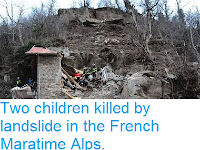Four people have been confirmed dead, one has been injured and another is still missing following an avalanche near Entraunes in the Alpes-Maritimes Department in southeastern France, at about 1.00 pm local time on Friday 2 March 2018. All of those effected are reported to have been taking part in a guided off-piste ski tour near the Mercantour National Park when they were struck by the avalanche.
The approximate location of the 1 March 2018 Entraunes avalanche. Google Maps.
Avalanches are caused by the mechanical failure of snowpacks;
essentially when the weight of the snow above a certain point exceeds
the carrying capacity of the snow at that point to support its weight.
This can happen for two reasons, because more snow falls upslope,
causing the weight to rise, or because snow begins to melt downslope,
causing the carrying capacity to fall. Avalanches may also be triggered
by other events, such as Earthquakes or rockfalls. Contrary to what is
often seen in films and on television, avalanches are not usually
triggered by loud noises. Because snow forms layers, with each layer
typically occurring due to a different snowfall, and having different
physical properties, multiple avalanches can occur at the same spot,
with the failure of a weaker layer losing to the loss of the snow above
it, but other layers below left in place - to potentially fail later.
Diagrammatic representation of an avalanche, showing how layering of snow contributes to these events. Expedition Earth.
The Alps have seen a number of avalanche related incidents this winter,
largely due to high levels of snowfall. This is, in turn caused by
warmer conditions over the Atlantic, which leads to higher rates of
evaporation over the ocean, and therefore higher rates of precipitation
over Europe, which falls as snow in cooler regions such as the Alps. This situation is likely to get worst this week after a significant cold front from the east brought plunging temperatures across Europe this week, which is expected to be replaced by a new wet front from the west over the weekend, depositing precipitation as more snow across the now cooler continent.
See also...
Follow Sciency Thoughts on Facebook.








